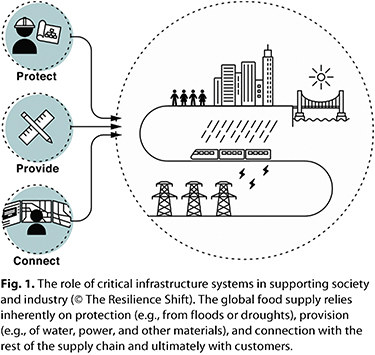 With a global population projected to approach 10 billion by 2050 and an increasing trend toward people living in cities (70% are expected to live in urban areas by the same date), a reliable supply of food is essential for the safety and well-being of billions of people. Urban communities are dependent on infrastructure systems to provide for their needs (Fig. 1). These communities do not have the resources to withstand disruptions, unless the systems on which they rely are resilient. Disruptions in infrastructure systems are frequently felt first and foremost by those who are most vulnerable (both small producers and poor urban consumers).
With a global population projected to approach 10 billion by 2050 and an increasing trend toward people living in cities (70% are expected to live in urban areas by the same date), a reliable supply of food is essential for the safety and well-being of billions of people. Urban communities are dependent on infrastructure systems to provide for their needs (Fig. 1). These communities do not have the resources to withstand disruptions, unless the systems on which they rely are resilient. Disruptions in infrastructure systems are frequently felt first and foremost by those who are most vulnerable (both small producers and poor urban consumers).
Food is a human right, not just a commodity, and ensuring that it reaches consumers safely and reliably, while supporting employment and economic growth, is essential. The United Nations Sustainable Development Goals (26), which set out a blueprint for “what matters” for people and the planet, provide a framework for developing a safe and reliable food system.
In this article, we focus on the resilience of food supply chains, in the specific context of the interdependent and complex nature of the transportation systems on which these supply chains rely. We define resilience as the“ability of a system to maintain a desired state of functionality after a disturbance and, hence, to continue to provide the service on which society depends. We draw on research undertaken to benchmark the position of industry globally and highlight a number of important concepts that have the potential to enhance resilience if integrated into decision-making.
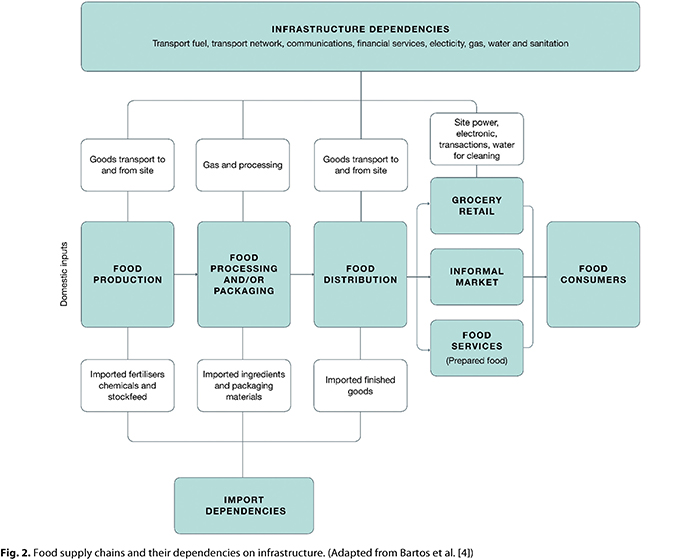
As shown in Figure 2, every part of a food supply chain depends on the reliable provision of infrastructure services. Infrastructure systems face increasing and diverse shocks and stresses, ranging from cyber attacks to long-term increases in temperature associated with climate change. These systems are increasingly interdependent and, as a result, are vulnerable to cascading failures both within and between systems. In addition, they are becoming more and more complex as digital solutions, automation, and artificial intelligence are added into existing systems.
Transportation is essential for distributing raw materials, labor, capital, and finished goods and services associated with the supply chain (9). The transportation lens used in this article is not intended to discount the importance of water, energy, or communication infrastructure in ensuring the safe and resilient distribution of food. The resilience of food systems to water and energy resource risks globally is also an area of focus in research and practice (12). The interdependencies between water, energy, transport, and food systems are illustrated in Figure 3.
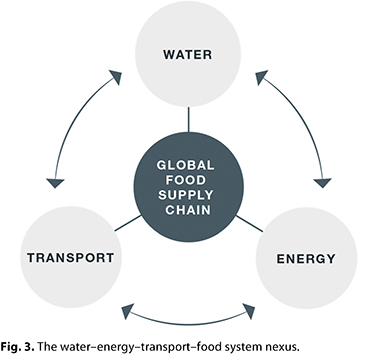 Defining Food Supply Chain Resilience
Defining Food Supply Chain Resilience
Food supply chain resilience is defined by Global Food Security (GFS) as “the system’s capacity to maintain a desired state of food security when exposed to stresses and shocks” (13). GFS further defines adaptation as “making changes in the system in order to deliver required outcomes” (13). This can cover a wide variety of actions, ranging from changing farming systems and reorienting consumption patterns to minimizing the impact of disruption to transportation infrastructure. A comprehensive definition of the concept of food system resilience, as a foundation for systems thinking and a holistic approach to dealing with challenges, is presented by Tendall et al. (25).
The View from Industry
Hallegatte et al. (14) report that in a survey of supply chain organizations in Tanzania, “when firms were asked why they cannot deliver on time to their clients, the most important factor cited by about a third of all firms was delays in their supply chain.”
In an industry dominated by private-sector actors, the view from industry is essential to benchmark the understanding and visibility of the resilience (or lack thereof) of transportation infrastructure. A global series of workshops was held to gauge the views of actors connected to grocery logistics and transportation (6), supported by stakeholder interviews (15,17,24) and literature review. In the U.K. context, it was notable that only 8% of organizations considered themselves to be truly agile and able to recover from events within 24 hours (15). In a global context (6), we learned that there were common challenges shared by workshop participants regardless of their location, such as poor planning and fragmented governance.
In the context of grocery logistics and transportation, “planning” can mean national planning frameworks, which do not necessarily support the market or provide flexibility in transportation options. It can also mean planning of supply chains themselves, in terms of a collective understanding of how they would respond to a disruptive event.
Fragmented governance is a common challenge to delivering resilient services, during both ordinary and extraordinary times. Typical challenges include lack of clear ownership and accountability, opaque decision-making, an absence of leadership during unexpected events, and lack of appropriate training to handle such events.
Possibly as a reflection of this fragmentation, we observed distinct regional differences, with a bias toward recent experiences. For example,
- Workshop participants in San Francisco, CA, U.S.A., identified the importance of disaster preparedness, particularly earthquakes.
- Lessons have been learned and processes implemented in New York, NY, U.S.A., following superstorm Sandy in 2012.
- Political instability impacting the supply chain emerged as a challenge in Johannesburg, South Africa, and the United Kingdom.
These findings suggest there is a need for lessons learned from recent crises to be transferred globally, not only within the affected region.
Disruption of infrastructure has been shown to lead to significant indirect economic losses. Modeling shows that if a major flood of the Seine River were to affect the Paris metropolitan area, up to 85% of the losses would be indirect business losses resulting from electricity and transport disruptions (23). These potential business losses should provide further incentives for collective action. Indeed, across our engagement with industry we found support for collective and individual actions to enhance resilience. One gap appears to be in the lack of clear guidance on best practices. Best practice guidance should include transferrable lessons from other industry sectors that are relevant to the food sector.
Through the rest of this article, we expand on some principles for enhancing the resilience of food transportation systems that are relevant globally and throughout the supply chain.
Essential Principles for Enhancing Food Transportation System Resilience
1) Accept Complexity and Interdependencies. A complex system is one in which the components can interact in unexpected ways that cannot necessarily be anticipated. The global, multimodal nature of food transportation, combined with the geopolitical, social, technical, and environmental elements that define the system, lead to complexity. Because it is market driven, food transportation systems can display the ability to adapt and self-organize, but can also be highly vulnerable to unforeseen disruptions.
Interdependencies between systems create the potential for a failure in one system to rapidly cascade to others. For example, the brown marmorated stink bug, an agricultural pest that is thriving in today’s warmer climate, has caused not only direct disruptions to food production (such as the hazelnut farming industry in Eastern Europe), but has also indirectly impacted other businesses, particularly shipping companies and car imports, as a result of the stringent biosecurity measures put in place in Australia and New Zealand to manage the pest (27). This cascading impact from food imports to car and other imports is an example of the systemic interdependencies of global trade routes.
Transportation networks are global, multimodal, and vulnerable to disruption, as shown in multiple historical examples, ranging from the oil embargoes in the 1970s, to port closures due to earthquake damage in Japan, to failures of poorly constructed or aging bridges in the United States. Transportation networks are also undergoing disruptive change due to technology innovations and the drive to reduce carbon emissions. These changes present opportunities to enhance resilience, but if they are not implemented in an integrated fashion, they could create further fragility in transportation networks.
2) Create a Connection between Safety and Resilience. The importance of safe food, as a human right, is widely recognized. In addition to sector-specific innovations, such as the ability to track and trace food from source to plate, the safety of food is related to its dependence on a resilient transportation infrastructure to transport it within the required timeframe, to ensure that materials arrive in a timely manner, to keep it at the required temperature during storage and transportation, and, ultimately, to ensure it can reach end users when they need it.
Therefore, consideration of the resilience of the wider transportation system, with its complexity and interdependencies, is an important aspect of ensuring end-to-end food safety.
3) Overcome Fragmentation between Actors in the Supply Chain. A key finding from the industry-focused research described earlier is one that resonates throughout infrastructure sectors globally. Governance, even within individual systems, is fragmented, which is a barrier to creating an integrated approach, improving preparation for shocks and stresses, and ensuring rapid recovery from disruptions.
Governance systems are as complex as physical systems, and no individual organization can recover from a shock in isolation from the rest of its “chain.” This lesson has been observed repeatedly in practice in other sectors but has not yet been widely transferred—for example, how multiple stakeholders in the city of Cape Town, South Africa, responded to the 2018 “Day Zero” water crisis (18).
Fragmented governance is exacerbated by the mix of public- and private-sector stakeholders within food supply chains: for example, road infrastructure is typically owned and operated by government bodies or by public–private partnerships, whereas many port operators are from the private sector and freight and shipping companies are almost all from the private sector. The challenge, therefore, is that no single agency is responsible for improving the resilience of the system or for mandating that different organizations work collaboratively (21).
There is no “silver bullet” solution to resolve fragmentation across supply chains, but there are some common themes: communication, collaborative engagement and strategies, understanding threats and hazards, and embedding best practices within and between organizations. A study of legislation of critical infrastructure resilience demonstrated that legislation can create these behaviors (20). The question is how can they be embedded in unregulated or lightly regulated industries?
We do not recommend attempting to solve this problem exclusively through centralization. Although such efforts are vital, relying entirely on centralization would reduce the overall flexibility and redundancy of the system and, hence, its capacity to respond, recover, self-organize, and continue to function under disruption. Local flexibility and redundancy are essential.
4) Adopt an “All Hazards” Approach to Shocks and Stresses. The Cambridge Centre for Risk Studies (7) lists the diverse and emerging range of natural and man-made threats facing countries around the world, from financial crises and geopolitics to floods and earthquakes. Elements of global food supply chains (Fig. 2) are potentially exposed to all of these threats, often simultaneously. These threats can be classified as either shocks (sudden, acute events) or stresses (gradual, chronic events). Companies operating globally or within global supply chains are exposed overall to many more threats, including different manifestations of climate change, from rising sea levels to extreme heat.
Using the best available data to assess the range of potential hazards and their effects is essential to designing and operating resilient systems (14). A resilience-focused approach recognizes that not all shocks and stresses can be avoided through risk mitigation, indeed many cannot even be predicted, yet measures can be put in place to improve the ability of the overall system to continue to function despite encountering shocks and stresses. An important lesson from the global engagement with industry (6) is that there is a regional bias in what organizations are worried about, which is often influenced by recent history. Yet, if there is one thing to learn from history, it is that we are always surprised.
Actions and interventions within the system that will enhance its resilience to “all hazards,” including those we cannot predict or avoid, can often be more cost-effective and better suited to the complexity and uncertainty of the system described above.
Examples of hazard-agnostic actions include “what if” analyses or scenario planning, for example, considering the failure of a critical service, such as electricity, regardless of the cause of the failure; sharing best practices and improving coordination between interdependent organizations; testing, monitoring, and inspections; or establishing robust data management systems to support rapid decision-making.
5) Avoid Creating New Vulnerabilities. Digital systems and technology are prevalent across today’s transportation networks, from connected and autonomous vehicles to advanced analytics that enable dynamic routing and logistics planning to internet companies that provide grocery delivery services.
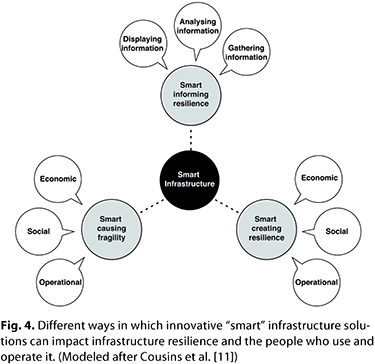 New modes of transport, such as drone delivery (5), are indicative of the rate of change in the sector. These innovations have great potential to enhance the resilience of systems to withstand unforeseen failures (Fig. 4)—for example, through real-time rerouting, the ability to manage demand and thereby reduce waste; use of distributed ledger technologies to manage food crises and recalls (19); and the availability and use of data to understand hazards. However, there are also new vulnerabilities created through the increasing reliance on automation and machines, particularly where different elements of an end-to-end system are fragmented and do not “talk” to each other (22).
New modes of transport, such as drone delivery (5), are indicative of the rate of change in the sector. These innovations have great potential to enhance the resilience of systems to withstand unforeseen failures (Fig. 4)—for example, through real-time rerouting, the ability to manage demand and thereby reduce waste; use of distributed ledger technologies to manage food crises and recalls (19); and the availability and use of data to understand hazards. However, there are also new vulnerabilities created through the increasing reliance on automation and machines, particularly where different elements of an end-to-end system are fragmented and do not “talk” to each other (22).
Traceability, for example through microbiomes (a mix of bacteria that is uniquely characteristic of each part of the world), creates the possibility of following a perishable product and its quality through every node of its transportation. All of this information, such as cold chain, localization, country of production, and shipping, will be “stamped” into a product. The use of this information to facilitate recovery from unexpected disruptions is an area with significant potential to enhance resilience, provided that the systems are sufficiently flexible, diverse, and able to adapt to change.
The rapid move toward electrification of road transport creates additional dependencies on the safe and reliable supply of electricity and, consequently, new vulnerabilities when this supply is not available. For example, cold-ironing, in which ships switch to a local electrical supply when berthed to improve air quality around ports, can place a significant additional demand on local power systems. Nevertheless, ships would be able to generate their own power in case of disruption to a port’s electricity supply.
As per the recommendations made in a study by the National Infrastructure Commission in the United Kingdom (22), the uptake of technological innovations is an essential feature of our future infrastructure. However, it can create new vulnerabilities, not only to malicious attacks, but also to emergent behaviors related to the complexity of new systems. This needs to be front of mind as new solutions are implemented.
6) Transfer Knowledge between Sectors. Christopher and Peck (8) state that “it is essential that individual business entities and those who manage them understand the extent of the network of which they are a part and systematically explore the network to identify its vulnerabilities.” This understanding is prevalent in the water sector, for example, where city-wide or basin-scale analyses are recognized as a best practice (10), perhaps because sufficient case studies exist to reinforce this view (1–3). However, this best practice is not followed universally and is often not transferred between different sectors, even though many of the challenges are universal—there are frequent examples of different sectors “reinventing the wheel.” This fragmented approach creates a feedback loop, whereby even as organizations start to move toward resilience-based approaches, when they do this in isolation the fragmentation continues and the overall system remains vulnerable.
We believe that the opportunity to transfer lessons from other sectors is significant and valuable. A common understanding across sectors will begin to deliver “system-thinking,” in which multiple organizations perceive their own role within a wider system and the mutual benefits of collaborating across the system (20).
An Integrated Approach
In summary, there is evidence that those throughout the food supply chain who rely on transportation systems to continue to function have insufficient visibility of the actual resilience (or lack thereof) of these systems. Improved integration and collaboration between different stakeholders (both public and private sector) is an essential step toward closing this gap and creating a more resilient food system overall.
The value of enhanced food supply chain resilience to all stakeholders should be evident and needs to be clearly articulated, whether the stakeholders are small producers whose businesses would be devasted, food distribution companies, retailers, or the communities who rely on a safe and reliable food supply. The role of different members of the value chain in delivering end-to-end resilience also needs to be clear—there is no “silver bullet” solution, but there are measures that everyone can implement. Measures that can be taken to enhance the physical robustness of the transportation infrastructure often have a high cost associated with them, but there are also, as discussed in this article, a number of principles that are not necessarily associated with higher capital or operating costs but with a simple shift in thinking and practice.
Government policy is important in creating a shift, whether it is a “carrot,” such as a financial incentive, or a “stick,” such as legislation and regulation (16); this government intervention is notably absent in the global food transportation networks, in which the emphasis currently is on more direct safety issues. There is a need for food safety policy to include the wider system on which food safety depends to truly deliver safe food for all.
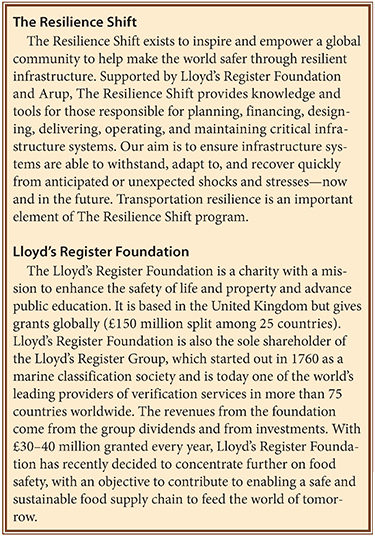 Future trends
Future trends
New tools and platforms directly facilitate collaboration among stakeholders. Traditionally, supply chains have been characterized by “arms-length,” even adversarial, relationships between different stakeholders, with a history of those serving supply chains being unwilling to share information, either with suppliers or customers, notably concerning transportation. However, technology and data are changing the way we think about, and operate, transportation systems. In today’s food industry, there is significant collaboration between manufacturers, retailers, government, and transportation companies in the form of collaborative planning, forecasting replenishment, and other initiatives to improve the resilience of the supply chain.
Of the food produced globally, 40% is wasted or lost, while more than 800 million people go to bed hungry every day. Losses through transportation and logistics chains are major contributors to this problem, both during ordinary and extraordinary times. Leveraging innovations and new systems, while being mindful of the need to not create new, unintended vulnerabilities, could provide a road map for feeding the entire planet with safe and traceable foods.
Acknowledgments
We thank Brian Bedard for his input and helpful comments. We would also like to thank the team at Arup who led the research and engagement in the reports on the resilience of global food supply chains (6) and the U.K. grocery supply chain (15).
 Juliet Mian is an experienced civil engineer with more than 20 years of experience working on major projects for Network Rail, Highways England, HS2, the National Infrastructure Commission, and many others in the United Kingdom and overseas. Juliet specializes in the resilience of infrastructure systems and is technical director, Resilience Shift, and associate director, infrastructure advisory, Arup. Juliet leads the Resilience Shift Programme of activities that aims to contribute to the enhancement of critical infrastructure resilience, so that it improves the safety and well-being of those it protects, connects, and provides for. Juliet is a Fellow of the Institute of Civil Engineers (ICE) and a chartered engineer. Juliet can be reached at Juliet.mian@arup.com.
Juliet Mian is an experienced civil engineer with more than 20 years of experience working on major projects for Network Rail, Highways England, HS2, the National Infrastructure Commission, and many others in the United Kingdom and overseas. Juliet specializes in the resilience of infrastructure systems and is technical director, Resilience Shift, and associate director, infrastructure advisory, Arup. Juliet leads the Resilience Shift Programme of activities that aims to contribute to the enhancement of critical infrastructure resilience, so that it improves the safety and well-being of those it protects, connects, and provides for. Juliet is a Fellow of the Institute of Civil Engineers (ICE) and a chartered engineer. Juliet can be reached at Juliet.mian@arup.com.
 Jan Reier Huse is vice president of Lloyd’s Register Foundation. He has worked with the Lloyd’s Register Group since 2009, primarily within the oil and gas sector. His previous engagements include a position in an oil company as HSE manager, capital projects, and operations. Jan Reier can be reached at Jan.Reier.Huse@lr.org.
Jan Reier Huse is vice president of Lloyd’s Register Foundation. He has worked with the Lloyd’s Register Group since 2009, primarily within the oil and gas sector. His previous engagements include a position in an oil company as HSE manager, capital projects, and operations. Jan Reier can be reached at Jan.Reier.Huse@lr.org.
 Xavier Aldea Borruel is a senior consultant in Arup’s International Development team and a chartered mechanical engineer. Xavier is currently programme manager for the Resilience Shift Programme, which aims to improve resilience within and between critical infrastructure sectors globally. Xavier has a strong background in manufacturing gained through his M.S. degree in industrial engineering, private-sector experience, and an MBA. His experience includes the adoption of value chains in the assessment of critical infrastructure resilience and leading a project to evaluate the dependency of global supply chains on critical infrastructure resilience, with a focus on the food sector. Xavier can be reached at Xavier.aldeaborruel@arup.com.
Xavier Aldea Borruel is a senior consultant in Arup’s International Development team and a chartered mechanical engineer. Xavier is currently programme manager for the Resilience Shift Programme, which aims to improve resilience within and between critical infrastructure sectors globally. Xavier has a strong background in manufacturing gained through his M.S. degree in industrial engineering, private-sector experience, and an MBA. His experience includes the adoption of value chains in the assessment of critical infrastructure resilience and leading a project to evaluate the dependency of global supply chains on critical infrastructure resilience, with a focus on the food sector. Xavier can be reached at Xavier.aldeaborruel@arup.com.
 Vincent Doumeizel leads the charitable objectives of the Lloyd’s Register Foundation, through the identification and funding of innovative projects to drive sustainability in the food supply chain. He is a member of various boards for disruptive agfood projects and a regular speaker at the world’s leading food events (FAO UN, OECD, COP, GFSI, etc.). Following a degree in economics, Vincent worked for the French government in Africa on agriculture projects and carried out humanitarian work in the Middle East. With 15 years of experience in food, Vincent joined Lloyd’s Register in 2014, as vice president for food and sustainability, serving more than 100 countries and thousands of clients with business assurance solutions. Vincent can be reached at Vincent.Doumeizel@lr.org.
Vincent Doumeizel leads the charitable objectives of the Lloyd’s Register Foundation, through the identification and funding of innovative projects to drive sustainability in the food supply chain. He is a member of various boards for disruptive agfood projects and a regular speaker at the world’s leading food events (FAO UN, OECD, COP, GFSI, etc.). Following a degree in economics, Vincent worked for the French government in Africa on agriculture projects and carried out humanitarian work in the Middle East. With 15 years of experience in food, Vincent joined Lloyd’s Register in 2014, as vice president for food and sustainability, serving more than 100 countries and thousands of clients with business assurance solutions. Vincent can be reached at Vincent.Doumeizel@lr.org.
